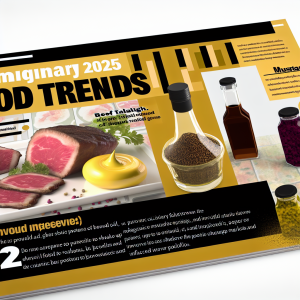The Specialty Food Association’s Summer Fancy Food Show just wrapped up in New York City, and it’s clear: condiments and pantry staples are undergoing a flavorful renaissance that savvy investors and food industry insiders can’t afford to overlook. Beyond the usual buzz, this year’s show revealed emerging trends and shifts that signal new market opportunities and evolving consumer preferences. Let’s dive into what’s next—and what it means for investors aiming to stay ahead of the curve.
Olive Oil Gets a Gourmet Makeover—Beyond the Bottle
Olive oil has long been a kitchen essential, but the traditional bottle is no longer enough to capture consumer interest. Castillo de Canena, a centuries-old Spanish olive oil producer, showcased innovative flavor infusions like harissa olive oil and olive oil aged in sherry casks. This trend toward artisanal and flavor-forward olive oils is part of a broader movement where consumers seek elevated, multi-sensory experiences even from everyday ingredients.
Investor Insight: The premium olive oil market is projected to grow at a CAGR of 7.5% through 2028 (source: Grand View Research). Brands that innovate with unique infusions and storytelling around heritage and craft stand to capture a growing segment of affluent and adventurous home cooks. Advisors should watch for emerging olive oil brands that combine tradition with innovation, as these could be ripe for acquisition or partnership by larger food conglomerates.
Mustard’s Moment: Texture and Tradition Reimagined
Mustard, often relegated to the back of the condiment aisle, is stepping into the spotlight with brands like Pop Mustards, which touts itself as the “caviar of mustards” due to its use of whole mustard seeds and fermentation techniques. Meanwhile, Caplansky’s Delicatessen offers a modern twist on classic deli mustards, proving that even traditional condiments can be revitalized with bold flavors and artisanal craftsmanship.
Market Implication: The global mustard market is expected to reach $2 billion by 2026 (source: MarketWatch), driven by consumer demand for gourmet and small-batch products. Investors should consider mustard brands that emphasize fermentation and unique textures, as these align with the broader “craft condiment” trend that appeals to millennials and Gen Z consumers seeking authenticity and novelty.
Plant-Based 2.0: Beyond Labels, Focus on Flavor
While plant-based foods have faced market saturation and growth challenges recently, the category is evolving. Instead of leading with vegan or vegetarian labels, brands like Umyum are focusing on taste and culinary craftsmanship, with products like cashew-based cheeses and vegan butters that appeal to all consumers, not just plant-based eaters.
Strategic Takeaway: Investors and advisors should pivot focus from plant-based products marketed solely on ethics or health to those emphasizing gourmet taste and versatility. This repositioning helps overcome “plant fatigue” and taps into mainstream consumers wanting better flavor profiles. Look for companies blending culinary expertise with plant-based innovation—these are likely to outperform in the next 3–5 years.
Chef-Led Brands: From Kitchen Passion to Retail Powerhouse
The pandemic accelerated a trend of chefs bottling their signature sauces and condiments for retail. This shift is proving durable, with chef-driven brands like Michael Solomonov’s Zahav Foods and Zane Caplansky’s mustard line gaining traction. These brands leverage the chef’s reputation and culinary credibility to command premium pricing and consumer trust.
What’s Next: Chef-led brands are poised to become acquisition targets for larger food companies seeking authentic, story-rich products. Investors should monitor chef entrepreneurs with scalable production capabilities and strong direct-to-consumer sales channels. Advisors might encourage clients to diversify portfolios by including emerging chef-driven food brands, which blend culinary artistry with commercial potential.
The “Swicy” Revolution: Sweet Meets Spicy, and It’s Here to Stay
“Swicy”—a clever mashup of sweet and spicy flavors—is evolving from a niche trend to a dominant flavor profile. Mike’s Hot Honey’s collaboration with Heluva Good and Slawsa’s sweet-spicy cabbage relishes exemplify this next-gen taste explosion. This flavor dynamic taps into consumers’ desire for bold, layered experiences.
Investor Alert: The sweet-spicy flavor segment is expanding rapidly, with spicy sauces and flavored honeys seeing double-digit growth annually (source: Nielsen). Brands innovating within this space, especially those combining health-conscious ingredients with exciting flavor profiles, present compelling growth opportunities. Advisors should advise clients to seek exposure to companies innovating in flavor-forward condiments and sauces.
Beef Tallow: Controversial but Trending
Beef tallow is making a comeback, partly fueled by high-profile endorsements like Robert F. Kennedy Jr.’s “Make America Healthy Again” campaign. Despite broad expert disagreement on its health benefits, products like Butcher Ben’s Beef Tallow and Beefy’s Own potato chips cooked in beef tallow are gaining niche popularity.
Caution and Opportunity: This trend is polarizing but represents a classic “contrarian” investment angle. Investors willing to navigate the health debate might find value in niche animal-fat-based products appealing to keto and carnivore diet followers. However, this space requires careful monitoring of regulatory and consumer sentiment shifts.
What Should Investors and Advisors Do Differently Now?
- Prioritize Flavor Innovation Over Labels: The market is moving beyond simplistic health claims. Products emphasizing taste, texture, and culinary craft are winning consumer loyalty.
- Look for Chef-Driven Authenticity: Chef-led brands are growing faster and attracting premium valuations. Keep an eye on culinary entrepreneurs with strong digital and retail presence.
- Explore Premium Condiment Categories: Mustards, infused olive oils, and “swicy” sauces are rapidly expanding segments with high consumer engagement.
- Be Open to Contrarian Bets: Trends like beef tallow may seem niche or controversial but can offer outsized returns if consumer interest grows.
- Monitor Sustainability and Heritage: Brands blending tradition with sustainability messaging—like Castillo de Canena’s centuries-old olive oil with modern twists—resonate deeply with consumers.
In 2024, the specialty food sector is not just about new flavors—it’s about storytelling, sensory experiences, and cultural relevance. Investors who grasp these nuances will find themselves ahead of the pack, capitalizing on trends that are reshaping how America eats and shops.
If you want to dig deeper into emerging food trends with actionable investment insights, stay tuned to Extreme Investor Network—where we turn culinary innovation into financial opportunity.
Source: 2025 food trends include beef tallow, mustard, flavored olive oil

